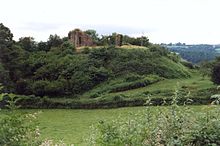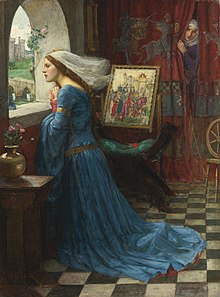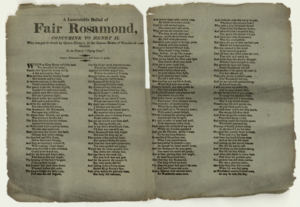Rosamund Clifford
Seeing the flowers and candles that covered the tomb, he ordered her remains to be moved and buried outside, "with the rest, that the Christian religion may not grow into contempt, and that other women, warned by her example, may abstain from illicit and adulterous intercourse".[6] Complying with the bishop's request, Clifford's body was moved to the cemetery by the nuns' chapter house and was destroyed during the dissolution of the monasteries (1536–1541) under Henry VIII.Paul Hentzner, a German traveller who visited England around 1599, recorded that her faded tombstone inscription read in part:[8]Another version tells that Rosamund was roasted between two fires, stabbed, and left to bleed to death in a bath of scalding water by the queen.[11] According to most medieval chroniclers, Queen Eleanor had been imprisoned by 1173 for raising her sons to be rebellious against their father, making a direct confrontation between the two women highly improbable.Legends have attributed to her two of the king's illegitimate sons, Geoffrey, Archbishop of York (c. 1152 – 1212) and William Longespée, 3rd Earl of Salisbury (c. 1176 – 1226).[9] However, Geoffrey was born before the king and Clifford even met from an otherwise unknown woman (possibly called Ykenai or Hikenai), and William was the son of Ida de Tosny, Countess of Norfolk (died after 1181).




William Bell ScottGodstow AbbeyHenry II of EnglandWalter de CliffordmedievalnoblewomanmistressHenry IIEnglish folkloreClifford Castlemarcher lordGerald of WalesWalterconventBenedictineQueen EleanoraffairBeaumount PalaceWoodstock PalaceHereford CathedralshrineHugh of LincolnBishop of LincolnChristianchapter housedissolution of the monasteriesHenry VIIIPaul HentznerrhymingepitaphchalicelabyrinthrumoursdaggerpoisonchroniclerJohn BromptonroastedElizabethan eraThomas DeloneySamuel DanielchambergardenscloisterEstrildisLocrinusballadchapbookMarie-Philippe Coupin de la CouperieEdward Burne-JonesEvelyn De MorganPre-RaphaeliteillegitimateGeoffrey, Archbishop of YorkWilliam LongespéeEarl of SalisburyIda de TosnyCountess of NorfolkBlenheim PalacespringWoodstocklandscape architectCapability BrownFrampton on Severnvillage greenRosa gallicaConcubineJohn William WaterhouseAlgernon SwinburneDer HeiligeConrad Ferdinand MeyerGuillaume ApollinaireNorah Loftsfamily sagaSusan HowatchJean PlaidyVirginia HenleySuzan SizemoreSharon Kay PenmanRobin PaigeAriana FranklinElizabeth ChadwickAlison WeirClara Dupont-MonodThe Lion in WinterWilliam MountfortJames GoldmanRosamondThomas ClaytonJoseph AddisonThomas ArneSingspielAnton SchweitzerChristoph Martin WielandRosmonda d'InghilterraGaetano DonizettiFair RosamondJohn BarnettGardner, MartinBBC News
